
Posted on 04/06/2015 4:14:39 AM PDT by Homer_J_Simpson


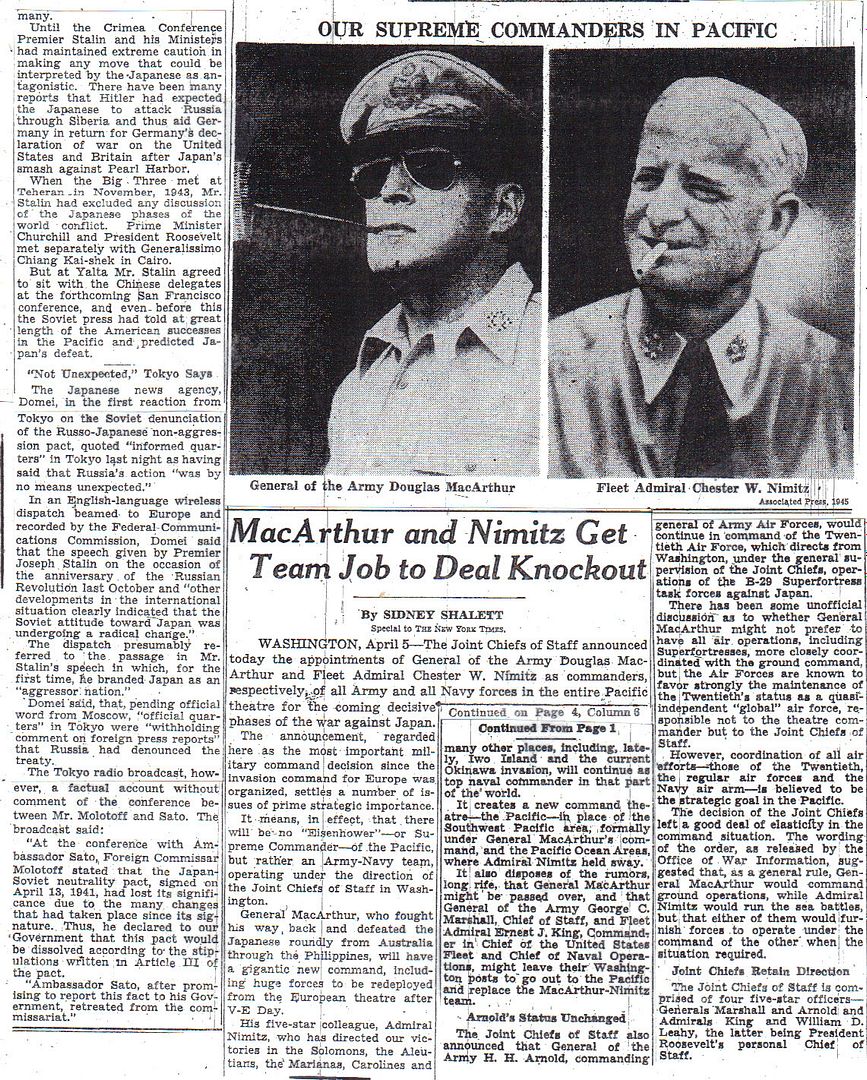

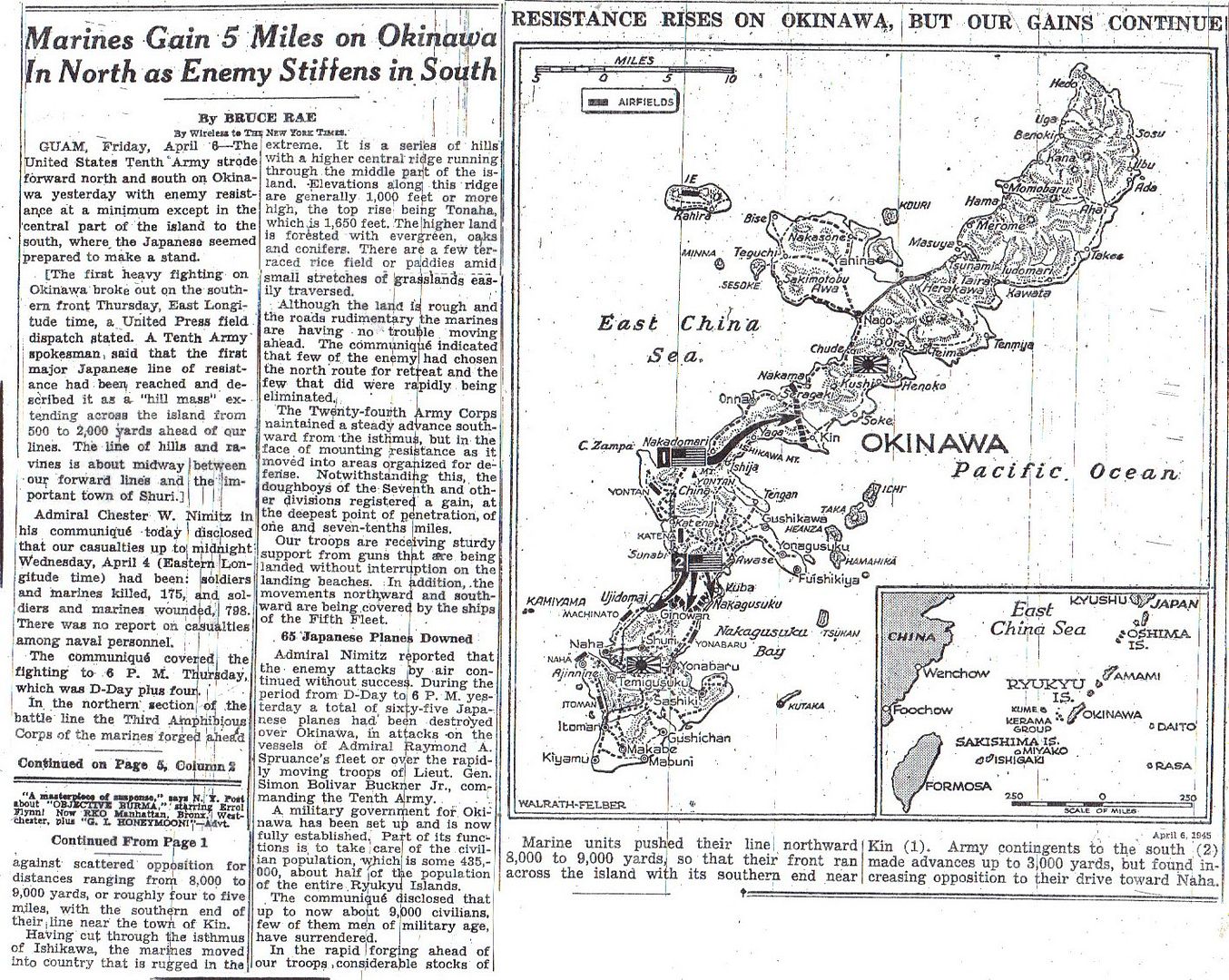
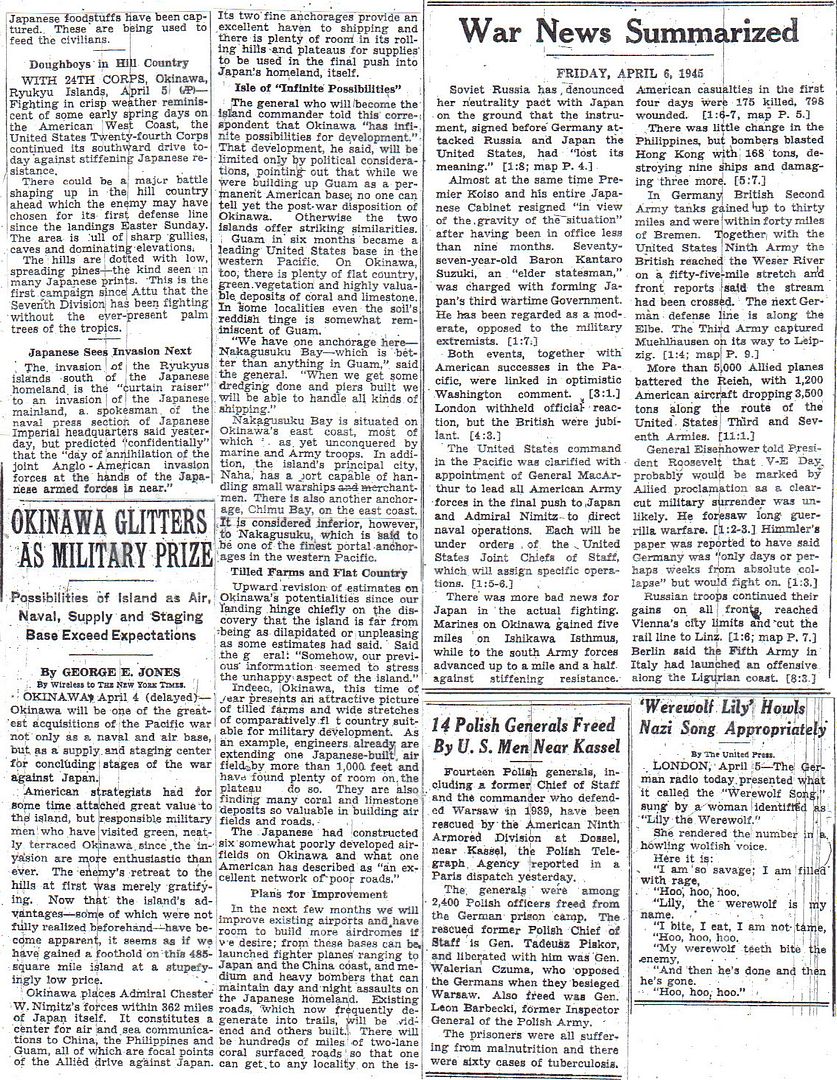
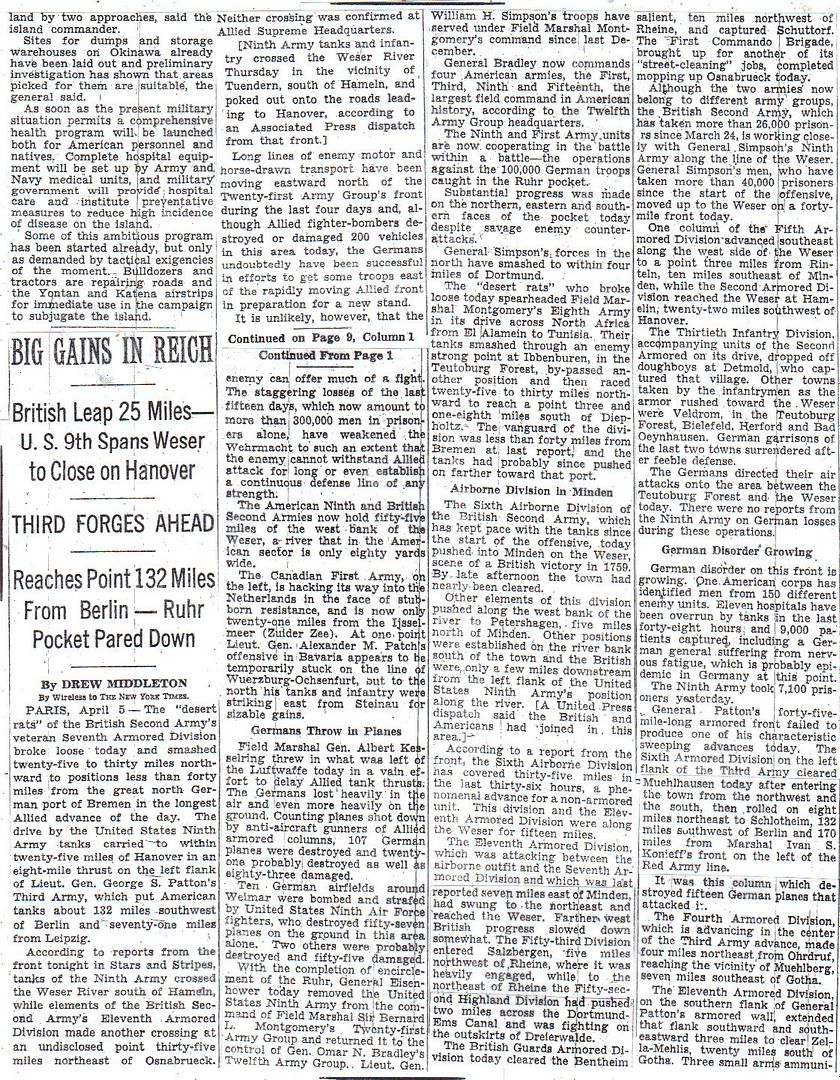
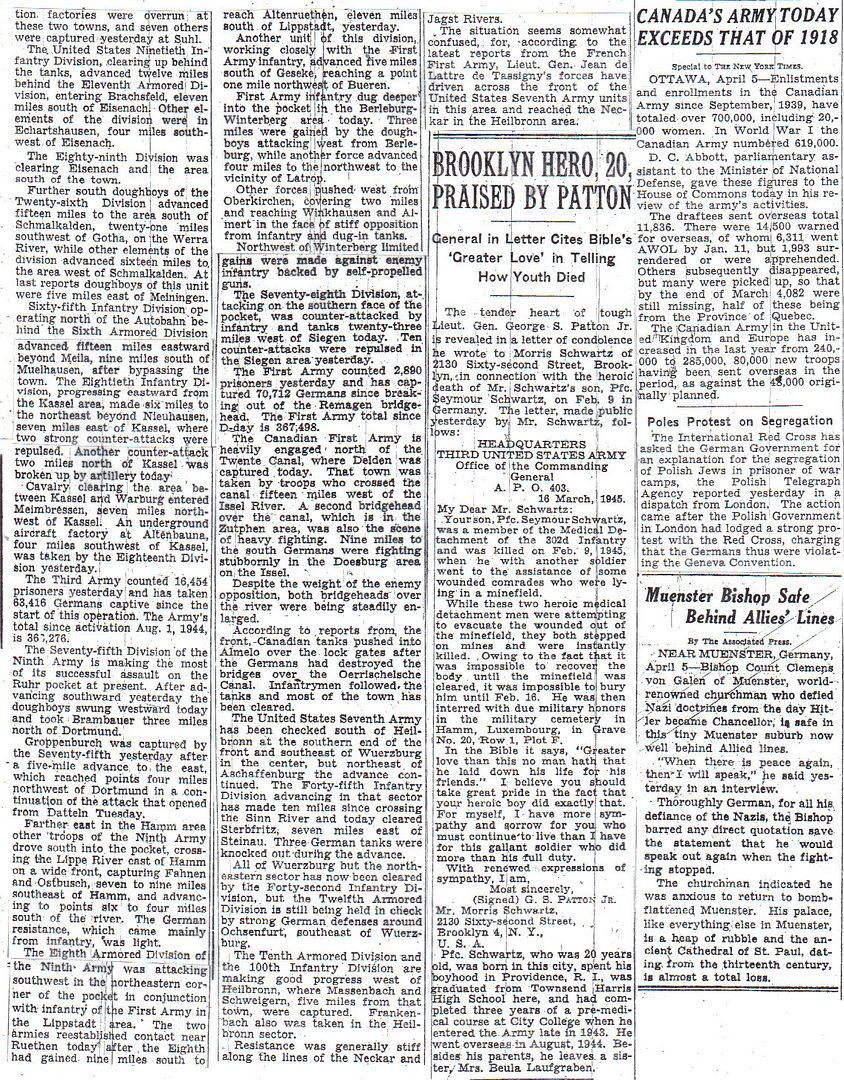


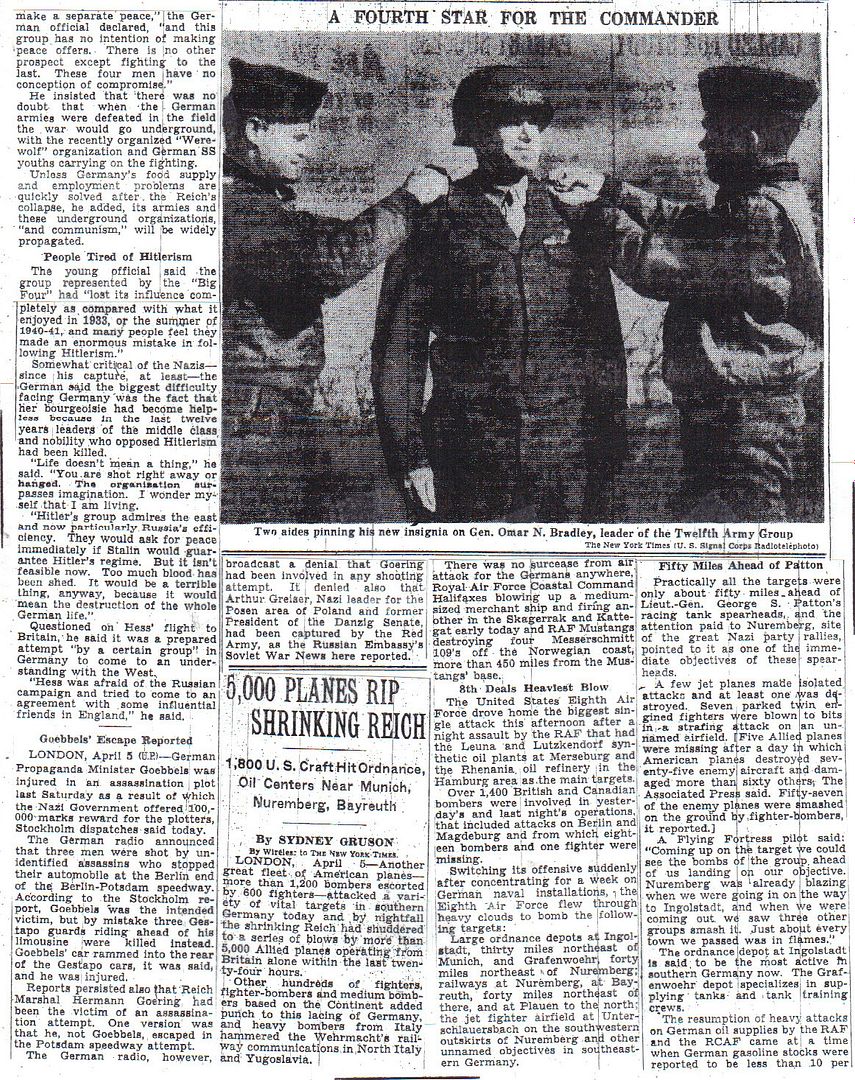
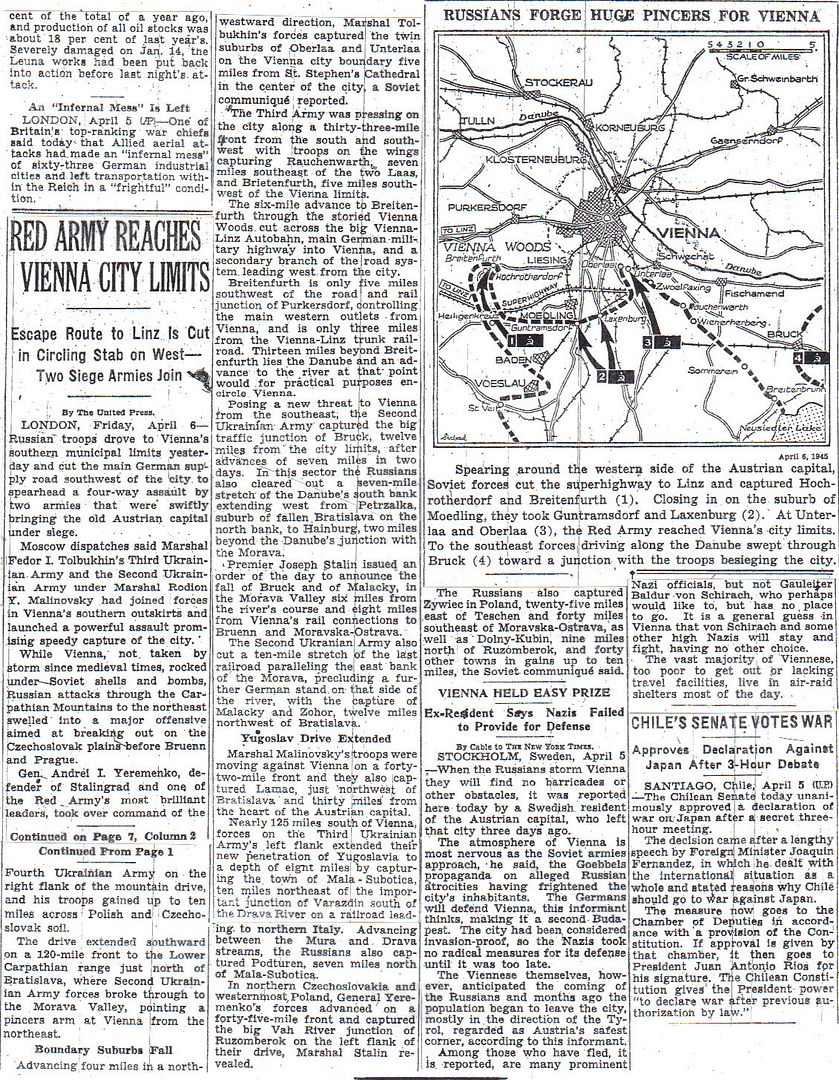
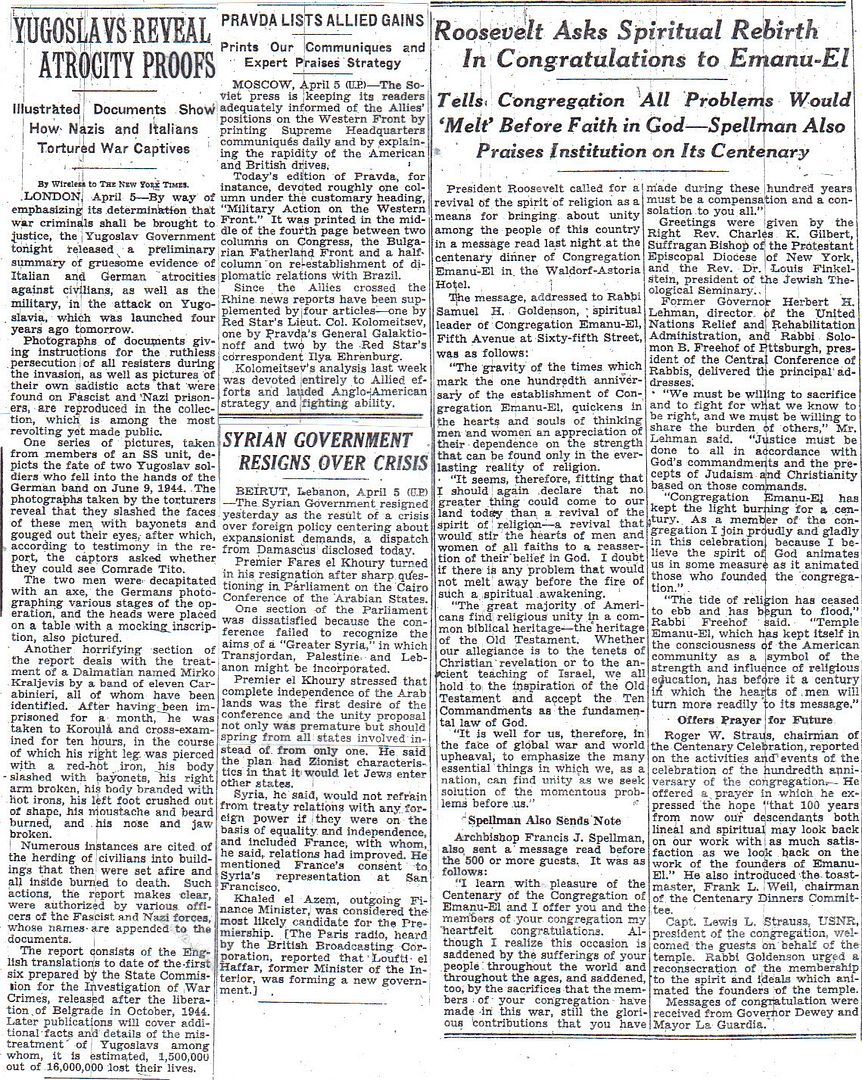

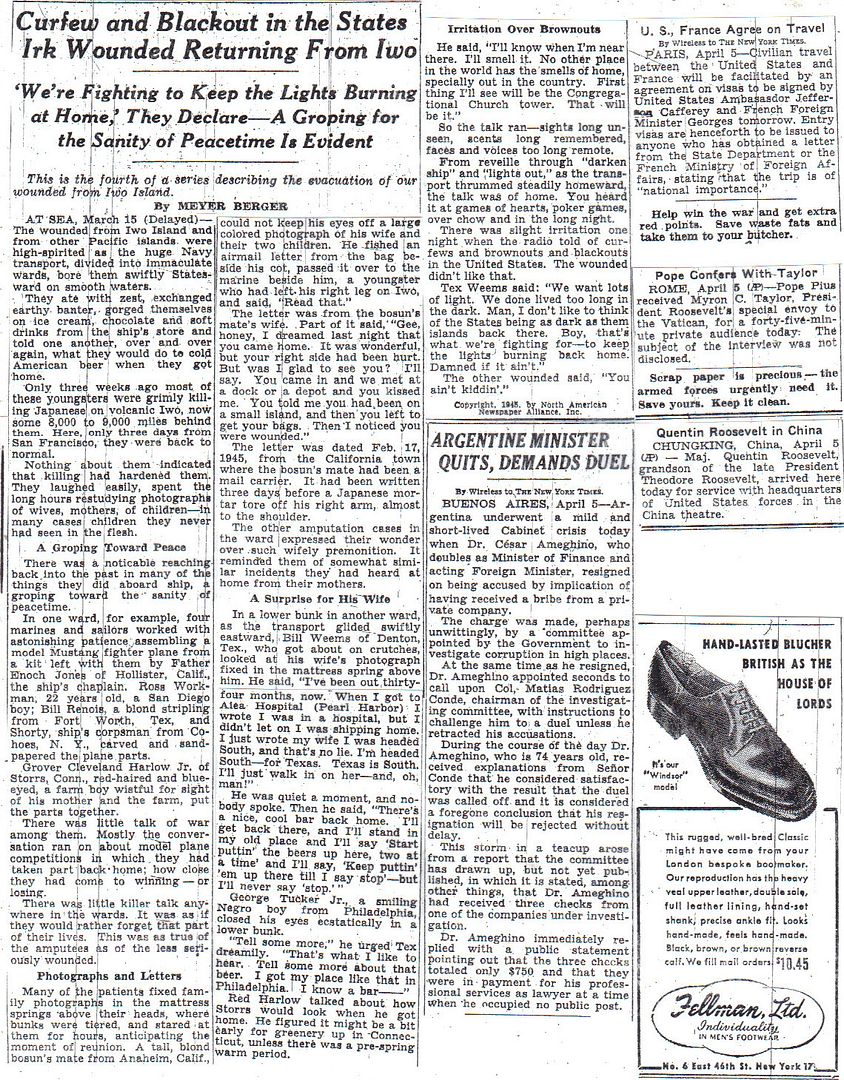
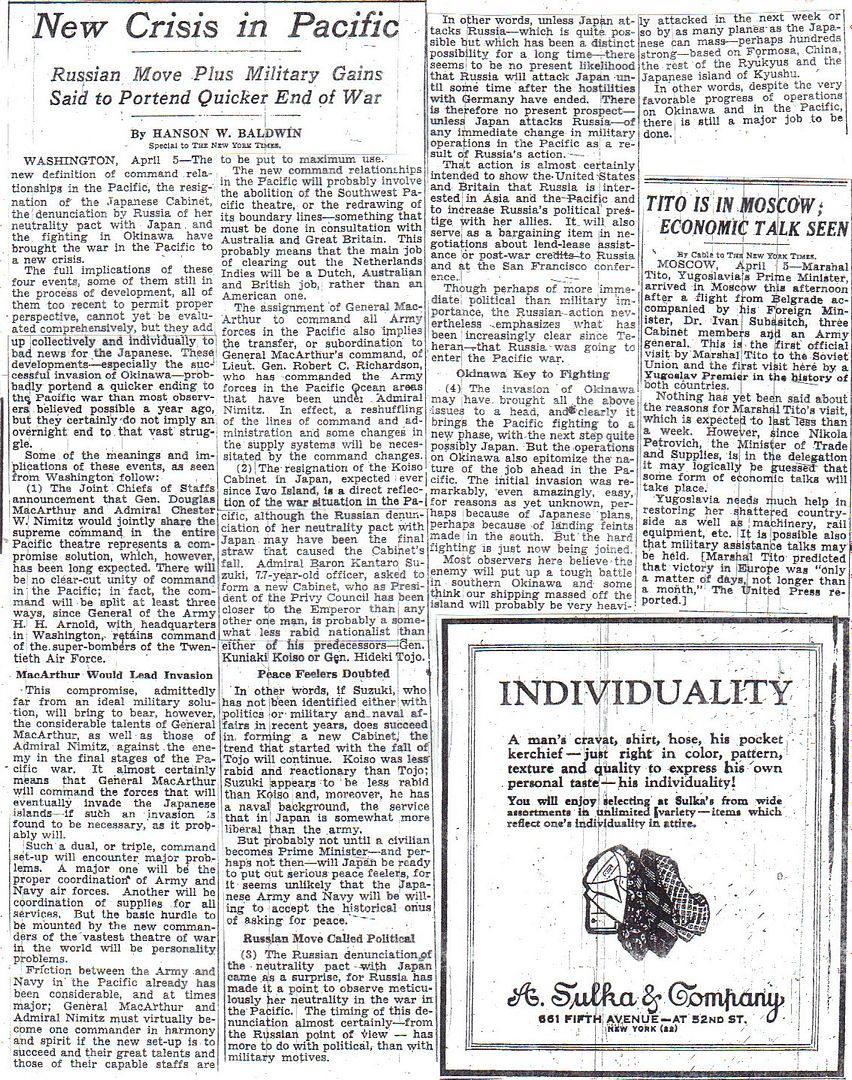


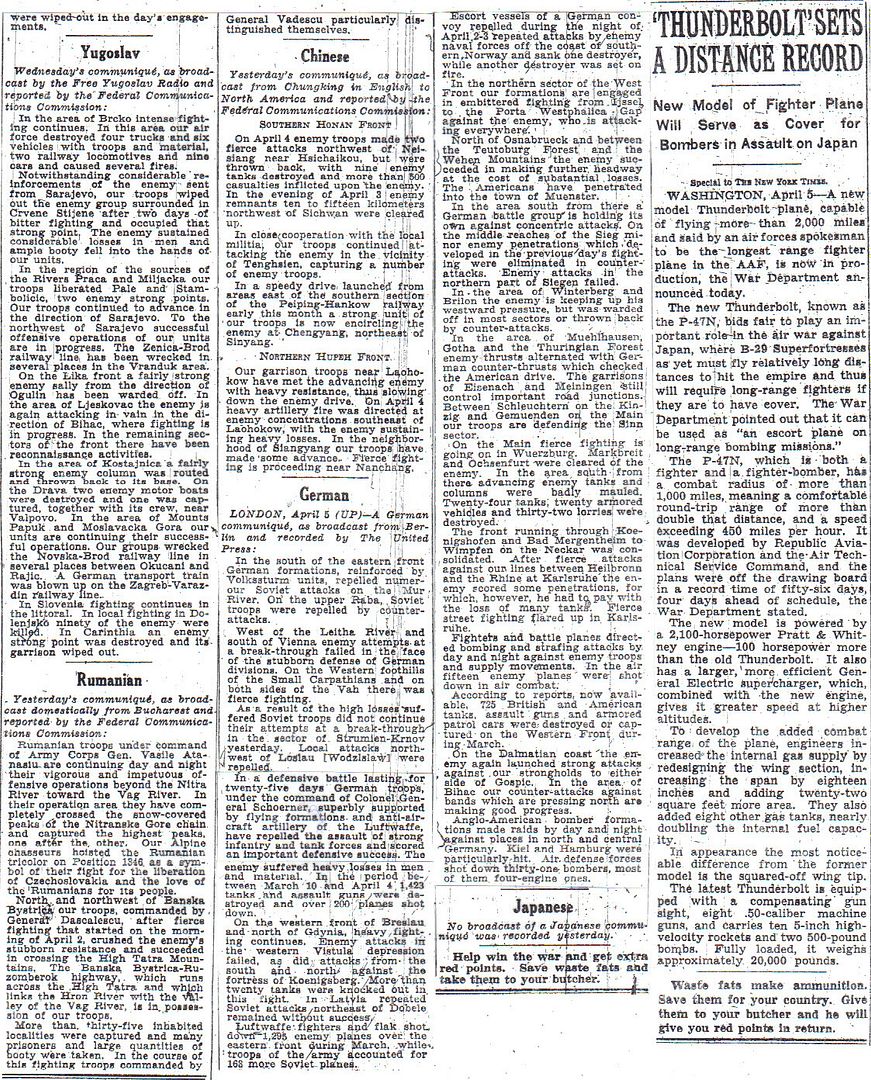
http://www.etherit.co.uk/month/3/06.htm
April 6th, 1945 (FRIDAY)
GERMANY:
The Red Army launches its attack on Königsberg, East Prussia.
The Germans move 15,000 Jewish prisoners out of Buchenwald camp.
Rühr: Two American armies with Rühr industrial heartland in their grip have been rounding up some 20,000 prisoners daily. With the figure already touching 100,000, they reckon the final total will be well over 300,000 when the final pockets of resistance from Field Marshal Walter Model’s Army Group B have been eliminated.
Simpson’s US Ninth Army came down from the north to join up with Hodge’s First at Lippstadt, east of the Rühr valley. In this area, Warburg was captured after German civilians armed with bazookas, put up token resistance to the First Army. The Ninth is now clearing up Hamm, a railway centre and industrial town on the northern edge of the Rühr and a regular RAF target over the years.
Some German units lodged in the many wooded areas in this region are apparently unaware of Allied movements. When fatigue parties came out to collect ammunition from a dump near Marburg they found Allied troops awaiting them.
Allied aircraft have dropped five million leaflets on the German forces trapped in the Rühr, giving news of the British, American and Canadian advances deep into the heart of the Third Reich.
At Hamelin, First Lieutenant Raymond O. Beaudoin, United States Army, Company F, 119th Infantry, 30th Infantry Division, led the 2d Platoon of Company F over flat, open terrain when the Germans went into action with machineguns and automatic weapons, laying down a devastating curtain of fire which pinned the Americans to the ground. By rotating men in firing positions he made it possible for his entire platoon to dig in, defying all the while the murderous enemy fire to encourage his men and to distribute ammunition. He then dug in himself at the most advanced position, where he kept up a steady fire, killing 6 hostile soldiers, and directing his men in inflicting heavy casualties on the numerically superior opposing force. Despite these defensive measures, however, the position of the platoon became more precarious, for the enemy had brought up strong reinforcements and was preparing a counterattack. Three men, sent back at intervals to obtain ammunition and reinforcements, were killed by sniper fire. To relieve his command from the desperate situation, 1st Lt. Beaudoin decided to make a l-man attack on the most damaging enemy sniper nest 90 yards to the right flank, and thereby divert attention from the runner who would attempt to pierce the enemy’s barrier of bullets and secure help. Crawling over completely exposed ground, he relentlessly advanced, undeterred by 8 rounds of bazooka fire which threw mud and stones over him or by rifle fire which ripped his uniform. Ten yards from the enemy position he stood up and charged. At point-blank range he shot and killed 2 occupants of the nest; a third, who tried to bayonet him, he overpowered and killed with the butt of his carbine; and the fourth adversary was cut down by the platoon’s rifle fire as he attempted to flee. He continued his attack by running toward a dugout, but there he was struck and killed by a burst from a machinegun. By his intrepidity, great fighting skill, and supreme devotion to his responsibility for the well-being of his platoon, 1st Lt. Beaudoin single-handedly accomplished a mission that enabled a messenger to secure help which saved the stricken unit and made possible the decisive defeat of the German forces. (MOH)
The Eighth Air Force flies Mission 930: 659 bombers are dispatched to hit rail targets in the Leipzig area using H2X radar; 4 B-17s and 1 P-51 are lost.
- 183 B-24s bomb the marshalling yard at Halle; 22 others hit Eisleben, a target of opportunity. Escorting are 201 P-47s and P-51s.
- 321 B-17s hit the main station and marshalling yard at Leipzig and 109 hit Gera; 11 others hit the marshalling yard at Halle; 4 B-17s are lost. The escort is 392 of 410 P-51s; 1 P-51 is lost.
99 Ninth Air Force B-26s, A-20s and A-26 Invaders hit marshalling yards at Gottingen and Northeim and the city area of Herzberg, and drop leaflets over 3 city areas; fighters fly escort, alerts, sweeps, and armed reconnaissance, and support the US VIII Corps in the Eisenach area, and the XX Corps east of the Werra River near Muhlhausen.
Deutsche Reichsbahn operates the Taifun Express, a special train of seventy tarpaulin covered cars (formerly used for V-2 parts) and twelve boxcars/passengers cars. The train is commanded by Luftwaffe 1st Lt. Dr. Klaus Schneufelen. The train transports all the machinery and raw materials needed to mass produce 700 Taifun unguided surface-air missiles from Camp Dora to Austria. The train departs Herzberg Station before noon today. It will skirt the western Harz Mountains via Osterode, Seesen and Goslar. (Sandy Bybee)
AUSTRIA: In a dramatic broadcast tonight, Vienna radio announced that the Russians had broken into the suburbs of the city. The broadcast was interrupted by the noise of heavy gunfire as Marshal Tolbukhin’s men penetrated to within a mile of the city centre.
“At this very moment,” said the announcer, “shells are howling over our heads, over the ancient tower of St. Stephen, the heavily-damaged Burgtheater and the castle of Schonbrunn. Our men are firing with all guns. Vienna Volkstürm formations have been deployed on a square. They are going into battle at any minute now to support the soldiers of the Wehrmacht fighting only a few kilometres away.
“We can see the bombs and shells crashing. The Russians are trying to enter the bulwark of the German south-east. The thunder of battle is enveloping the front-line city of Vienna.” Then, after a short interlude of Viennese music, the announcer called for a “backs to the wall” defence of the city.
ITALY: Second Lieutenant Vernon Baker of the US Army showed outstanding courage and leadership in destroying German installations. Personally killing five Germans. MOH.
Twelfth Air Force A-20s and A-26s on night intruder missions during the night of 5/6 April, bomb several bridges in the Po River Valley, scoring good results on 8 of the targets, also hitting an assembly area along the Po River; XXII Tactical Air Command fighters and fighter-bombers hit lines of communications, mainly in the Po Valley, and support US Fifth Army forces attacking toward Massa Lombarda; B-25s cancel missions against targets on the Brenner line due to weather, but hit 6 bridges in the central Po Valley and gun positions at La Spezia.
The Fifteenth Air Force dispatches 387 B-17s and B-24s, with fighter escort, to bomb marshalling yard flak positions and an ordnance depot at Verona and a marshalling yard and small arms plant at Brescia; 179 other bombers sent against targets in northern Italy are recalled; 81 P-38s dispatched to bomb a bridge in Austria abort due to weather; 14 manage to attack bridges near the Austro-Italian border; 6 P-51s (of 54 airborne) strafe railroad targets in the Straubing-Plattling, Germany area; others fly reconnaissance missions.
BURMA: With improving weather conditions combat strikes by the Tenth Air Force in the central Burma battle area increase; 70+ fighter-bombers attack troop concentrations, artillery positions, tanks, trucks, fuel dumps, and general targets of opportunity along and immediately behind enemy lines; targets are located in several areas including Paklu, Nawnghkio, Loilem, Takaw, Mong Hko, Kongleng, Nawnghsan Pu, and Indaw; air supply sorties continue on a steady basis throughout the day.
CHINA: 3 Fourteenth Air Force B-24s hit targets of opportunity in the Bakli Bay area on Hainan Island and 8 P-51s blast railroad targets of opportunity, troops, horses, and boat landings in the Chenghsien area and along the Lung Hai railroad and Yellow River.
FORMOSA: Fifth Air Force B-25s bomb the town of Hokko.
FRENCH INDOCHINA: 4 Fourteenth Air Force P-38s knock out a bridge in the Dien Bien Phu area.
CENTRAL PACIFIC: 11 Seventh Air Force B-24s from Guam bomb positions and the airfield on Marcus Island.
JAPAN: HIJMS Yamato sails from the Inland Sea on a Kamikaze mission to Okinawa. There is only enough fuel on board for a one way trip.
Those were the orders, but according to Russell Spurr in “A Glorious Way to Die,” the officers at the Imperial Navy’s main fuel depot refused to condemn YAMATO and her consorts in this way. They tapped a secret reserve, hand-pumping the dregs from otherwise empty tanks, which were normally irrecoverable. Thus the ships had much more than their allotted allowance of oil, although of course they really didn’t have a prayer in any case. (Keith Allen)
The Japanese kamikaze onslaught against the US Navy begins off Okinawa. Kamikazes sink two destroyers (DDs) (one is scuttled after being hit by four kamikazes) and one landing ship tank (LST); and damage one light aircraft carrier (CVL), nine destroyers (DD), three destroyer escorts, three high-speed minesweepers (DMSs), five minesweepers (AMs), two motor minesweepers (YMSs) and one landing ship tank (LST).
http://www.liveleak.com/view?i=918_1246024954
US forces have blasted their way ashore at the island of Okinawa, some 340 miles south of Kyushu. Okinawa is to provide a “springboard” for the invasion of Japan later this year. The landings began on 1 April along a ten-mile stretch of the south-west coast, with a mammoth invasion fleet in support. Within an hour 16,000 Americans were ashore, and by 10am the important Kadena and Yontan airfields were in US hands. The absence of any real opposition from the Japanese puzzled the Americans. It was like a peacetime army exercise.
The Okinawa invasion - Operation Iceberg - is the largest amphibious landing of the Pacific War. Expecting heavy opposition, the Americans assigned the Tenth Army, commanded by Lt-Gen Simon Buckner, comprising three Marine and five army divisions, to take Okinawa. The total force consists of 548,000 army, navy and Marine personnel with 320 combat and 1,140 auxiliary vessels. In support are task forces of the US Navy together with the British Pacific Fleet. To isolate Okinawa before the landing, US carrier aircraft pounded Japanese airfields in Kyushu. B-29s interrupted their fire-bombing of Japanese cities to join in these attacks. The Americans plan to build air bases on the 60 mile long island for the aerial bombardment of Japan. The island also has room to provide bases to support the coming invasion of Japan itself.
The Japanese have some 120,000 troops on Okinawa. They avoided the crippling effects of US air and naval fire-power by stationing only token forces on the beaches and establishing strong defensive positions inland where they can meet the Americans in battle beyond the range of naval gunfire. But desperate measures are planned elsewhere. Kamikaze attacks are under way, and have already damaged the US battleship WEST VIRGINIA and the British carrier INDOMITABLE.
On Okinawa the US XXIV Corps, after cutting the island in two, turned south on 3 April in a drive towards the formidable Shuri Line. At the same time III Amphibious Corps moved north, meeting ever-stiffer resistance. Today Japan made mass attacks on Allied naval forces, sinking six warships and heavily damaging the US fleet carrier HANCOCK. The Japanese used 335 kamikazes, as well as a large number of other aircraft in these attacks.
Eleventh Air Force bombers attacks targets in the KURILE ISLANDS: 8 B-24s attack and photograph Kurabu on Paramushiru Island, especially the airfield, while 8 B-25s hit radar installations in an all-out attack on Hayakegawa, Kotani Island, and Minami Cape, dropping napalm-filled incendiaries for the first time; buildings and shipping in northern part of Hayakegawa are hit especially hard; another B-25 flies weather reconnaissance.
COMMONWEALTH OF THE PHILIPPINES: US Army Forces, Pacific (AFPAC) is established at Manila under General of the Army Douglas MacArthur”> MacArthur. MacArthur and Nimitz for the time being retain their responsibilities as commander of all Allied forces in the Southwest Pacific and Pacific Ocean areas respectively.
But these commands are to be phased out in favour of a new arrangement. MacArthur is named Commander in Chief, U.S. Army Forces, Pacific, and will eventually assume command of all Army forces in the Pacific, with some minor exceptions. Similarly, Nimitz, is his capacity as commander of the Pacific Fleet, will eventually be given command of all naval forces in the Pacific, including Seventh Fleet, which currently is under MacArthur’s theatre command. The projected invasion of Japan will be conducted with this new structure. (Keith Allen)
Far East Air Forces missions: On Luzon Island, ground support sorties continue in areas around Balete Pass, west of Ft Stotsenburg, north, northeast and south of Laguna de Bay, and around Legaspi and Far East Air Forces fighters hit Carabao Island and Infanta. On Cebu, B-24s bomb a town north of Cebu City while fighters support ground units. A-20s support ground forces on Negros Island and B-25s pound Bunawan on Mindanao. B-24s bomb Jolo Island, Philippine Island defences and ammunition and supply dumps.
Seventh Air Force missions: 23 B-24s from Angaur Island in the Palau Islands bomb barracks and a wharf at Bunawan on Mindanao.
Can anyone imagine any of today's Democrats saying such things?
http://marshallfoundation.org/library/digital-archive/to-general-of-the-army-dwight-d-eisenhower-20/
General George C. Marshall To General of the Army Dwight D. Eisenhower, April 6, 1945
1945
Publisher: The Johns Hopkins University Press
Date: April 6, 1945
Subject: World War II
Collection: Papers of George Catlett Marshall, Volume 5: The Finest Soldier
Summary
To General of the Army Dwight D. Eisenhower
April 6, 1945 Radio No. WAR-64236. Washington, D.C.
Top Secret
For Eisenhower’s EYES ONLY from Marshall.
Discussion here by G-2 and Mr. Stimson relates to effect of complete destruction of Ruhr industry and economic future of Europe, destruction that would result from further Allied offensive action.1 Admiral Leahy, King, Handy and Hull are opposed to asking you any question.
Aside from purely military considerations concerned with advancement of campaign to destroy the German Army there are two schools of thought in high government circles here regarding a post war pastoral Germany and a policy of leaving some industrial capability to benefit the related economy of other European countries lacking Ruhr resources.
We naturally assume that you are proceeding in the manner best adapted to the security and rapidity of your thrusts into Germany.
Without thought of compromising yourself or in effect limiting your present military intentions will you please give me for no other eyes but Mr. Stimson’s, mine, Handy’s and Hull’s, most confidentially your present intentions as to Ruhr pocket and your view as to desirability or feasibility of any procedure by which the Ruhr proper might be sealed off.
I assume your forces are already deeply committed to operations directed against the pocket. This message must not in any way embarrass you or have the slightest effect in limiting your present point of view or intentions. As yet I have no views whatsoever in this matter, except that I think the fat is probably now in the fire and whatever the political conclusions it is too late, too impracticable to take any action for such reason.2
Document Copy Text Source: George C. Marshall Papers, Pentagon Office Collection, Selected Materials, George C. Marshall Research Library, Lexington, Virginia.
Document Format: Typed radio message.
1. Secretary of War Stimson reported that the April 6 meeting with Operations and Intelligence (G-2) staff had brought up the “problem of the Ruhr.” Major General Clayton L. Bissell, assistant chief of staff, G-2, pointed out that American troops encircled the Ruhr. “Should we clean the pocket up now or should we bypass it and let it starve into submission, using the rest of our troops to conquer the rest of Germany? It was a vital big question which lies before Eisenhower today and one in which Marshall apparently felt and I felt it was a case where we should at least discuss it with him.” If we conquer the Ruhr now, “we must smash practically everything in it, . . . wipe out the most important industrial area in Europe, the source of Europe’s trade and commerce more than any other one spot; the factories, even the mines, will all be smashed perhaps into irreparable ruin if our troops have to take it in the way we are taking the other cities of Germany today.” However, “if we bypass it, simply containing it, and finish up with the rest of Germany, it will take time; the Ruhr will ultimately fall in our hands but we may endanger quick success in the rest of Germany by the absence of the troops which we will be obliged to leave around the perimeter of the Ruhr.” (April 6, 1945, Yale/H. L. Stimson Papers [Diary, 51: 13].)
2. “I regard the substantial elimination of the enemy forces in the Ruhr as a military necessity,” replied Eisenhower on April 7. “At the very least we must compress his remaining elements into a relatively small area where they may be contained with a few divisions and so that our problem of maintenance may be minimized our main attacks against the pocket are coming from the east and southeast.” Eisenhower reported that while “accomplishing the substantial destruction of the enemy in the Ruhr area we have no intention of inflicting useless or unnecessary damage on existing facilities.” (Papers of DDE, 4: 2588-90.) Marshall forwarded Eisenhower’s reply to Secretary Stimson with the note: “General Eisenhower has transmitted the attached radio regarding the Ruhr for the eyes only of yourself, General Handy, General Hull, and me.” (Marshall Memorandum for the Secretary of War, April 8, 1945, GCMRL/G. C. Marshall Papers [Pentagon Office, Selected].)
Recommended Citation: ThePapers of George Catlett Marshall, ed.Larry I. Bland and Sharon Ritenour Stevens(Lexington, Va.: The George C. Marshall Foundation, 1981- ). Electronic version based on The Papers of George Catlett Marshall, vol. 5, “The Finest Soldier,” January 1, 1945-January 7, 1947 (Baltimore and London: The Johns Hopkins University Press, 2003), pp. 132-133.
Yamato sails from Tokuyama, April 6, 1945
Yamato was the lead ship of the Yamato class of Imperial Japanese Navy World War II battleships. She and her sister ship, Musashi, were the heaviest and most powerfully armed battleships ever constructed, displacing 72,800 tonnes at full load and armed with nine 46 cm (18.1 inch) 45 Caliber Type 94 main guns. Neither ship survived the war.
Named after the ancient Japanese Yamato Province, Yamato was designed to counter the numerically superior battleship fleet of the United States, Japan's main rival in the Pacific. She was laid down in 1937 and formally commissioned a week after the Pearl Harbor attack in late 1941. Throughout 1942, she served as the flagship of the Japanese Combined Fleet, and in June 1942 Admiral Isoroku Yamamoto directed the fleet from her bridge during the Battle of Midway, a disastrous defeat for Japan. Musashi took over as the Combined Fleet flagship in early 1943, and Yamato spent the rest of the year, and much of 1944, moving between the major Japanese naval bases of Truk and Kure in response to American threats. Although present at the Battle of the Philippine Sea in June 1944, she played no part in the battle.
The only time Yamato fired her main guns at enemy surface targets was in October 1944, when she was sent to engage American forces invading the Philippines during the Battle of Leyte Gulf. On the verge of success the Japanese force turned back, believing they were engaging an entire US carrier fleet rather than the light escort carrier group that was all that stood between the battleship and the vulnerable troop transports.
During 1944, the balance of naval power in the Pacific decisively turned against Japan, and by early 1945 its fleet was much depleted and badly hobbled by critical fuel shortages in the home islands. In a desperate attempt to slow the Allied advance, Yamato was dispatched on a one-way mission to Okinawa in April 1945, with orders to beach herself and fight until destroyed protecting the island. The task force was spotted south of Kyushu by US submarines and aircraft, and on 7 April 1945 she was sunk by American carrier-based bombers and torpedo bombers with the loss of most of her crew.
Operation Ten-Go:
As the final step before their planned invasion of the Japanese mainland, Allied forces invaded Okinawa on 1 April. The Imperial Japanese Navy's response was to organise a mission codenamed Operation Ten-Go that would see the commitment of much of Japan's remaining surface strength. Yamato and nine escorts (the cruiser Yahagi and eight destroyers) would sail to Okinawa and, in concert with kamikaze and Okinawa-based army units, attack the Allied forces assembled on and around Okinawa. Yamato would then be beached to act as an unsinkable gun emplacement and continue to fight until destroyed. In preparation for the mission, Yamato had taken on a full stock of ammunition on 29 March.[22] According to the Japanese plan, the ships were supposed to take aboard only enough fuel for a one way voyage to Okinawa, but additional fuel amounting to 60 percent of capacity was issued on the authority of local base commanders. Designated the "Surface Special Attack Force", the ships left Tokuyama at 15:20 on 6 April.
Unfortunately for the Japanese, the Allies had intercepted and decoded their radio transmissions, learning the particulars of Operation Ten-Go. Further confirmation of Japanese intentions came around 20:00 when the Surface Special Attack Force, navigating the Bungo Strait, was spotted by the American submarines Threadfin and Hackleback. Both reported Yamato's position to the main American carrier strike force, but neither could attack because of the speed of the Japanese ships—22 knots (25 mph; 41 km/h)—and their extreme zigzagging.
The Allied forces around Okinawa began to brace for an assault. Admiral Raymond Spruance ordered six battleships already engaged in shore bombardment in the sector to prepare for surface action against Yamato. These orders were countermanded in favor of strikes from Admiral Marc Mitscher's aircraft carriers, but as a contingency the battleships together with seven cruisers and twenty one destroyers were sent to interdict the Japanese force before it could reach the vulnerable transports and landing craft.
Yamato's crew were at general quarters and ready for anti-aircraft action by dawn on 7 April. The first Allied aircraft made contact with the Surface Special Attack Force at 08:23; two flying boats arrived soon thereafter, and for the next five hours, Yamato fired Common Type 3 or Beehive (3 Shiki tsûjôdan) shells at the Allied seaplanes, but could not prevent them from shadowing the force. Yamato obtained her first radar contact with aircraft at 10:00; an hour later, American F6F Hellcat fighters appeared overhead to deal with any Japanese aircraft that might appear. None did.
At about 12:30, 280 bomber and torpedo bomber aircraft arrived over the Japanese force. Asashimo, which had earlier fallen out of formation due to engine trouble, was caught and sunk by a detachment of aircraft from San Jacinto. The Surface Special Attack Force increased speed to 24 knots (28 mph; 44 km/h), and following standard Japanese anti-aircraft defensive measures, the destroyers began circling Yamato. The first aircraft swooped in to attack at 12:37. Yahagi turned and raced away at 35 knots (40 mph; 65 km/h) in an attempt to draw off some of the attackers; it drew off only an insignificant number. Yamato was not hit for four minutes, but at 12:41 two bombs obliterated two of her triple 25 mm anti-aircraft mounts and blew a hole in the deck. A third bomb then destroyed her radar room and the starboard aft 127 mm mount. At 12:46, another two bombs struck the battleship's port side, one slightly ahead of the aft 155 mm centreline turret and the other right on top of the gun. These caused a great deal of damage to the turret and its magazines; only one man survived. At 12:45 a single torpedo struck Yamato far forward on her port side, sending extreme shocks throughout the ship. Because many of the ship's survivors were later killed by strafing or were trapped when Yamato sank, the details are uncertain, but authors Garzke and Dulin record that little damage was caused. Shortly afterward, up to three more torpedoes struck Yamato. Two impacts, on the port side near the engine room and on one of the boiler rooms, are confirmed; the third is disputed but is regarded by Garzke and Dulin as probable because it would explain the reported flooding in Yamato 's auxiliary steering room. The attack ended around 12:47, leaving the battleship listing 5–6° to port; counterflooding—deliberately flooding compartments on the other side of the ship—reduced the list to 1°. One boiler room had been disabled, slightly reducing Yamato 's top speed, and strafing had incapacitated many of the gun crews who manned Yamato 's unprotected 25 mm anti-aircraft weapons, sharply curtailing their effectiveness.
At about 12:30, 280 bomber and torpedo bomber aircraft arrived over the Japanese force. Asashimo, which had earlier fallen out of formation due to engine trouble, was caught and sunk by a detachment of aircraft from San Jacinto. The Surface Special Attack Force increased speed to 24 knots (28 mph; 44 km/h), and following standard Japanese anti-aircraft defensive measures, the destroyers began circling Yamato. The first aircraft swooped in to attack at 12:37. Yahagi turned and raced away at 35 knots (40 mph; 65 km/h) in an attempt to draw off some of the attackers; it drew off only an insignificant number. Yamato was not hit for four minutes, but at 12:41 two bombs obliterated two of her triple 25 mm anti-aircraft mounts and blew a hole in the deck. A third bomb then destroyed her radar room and the starboard aft 127 mm mount. At 12:46, another two bombs struck the battleship's port side, one slightly ahead of the aft 155 mm centreline turret and the other right on top of the gun. These caused a great deal of damage to the turret and its magazines; only one man survived. At 12:45 a single torpedo struck Yamato far forward on her port side, sending extreme shocks throughout the ship. Because many of the ship's survivors were later killed by strafing or were trapped when Yamato sank, the details are uncertain, but authors Garzke and Dulin record that little damage was caused. Shortly afterward, up to three more torpedoes struck Yamato. Two impacts, on the port side near the engine room and on one of the boiler rooms, are confirmed; the third is disputed but is regarded by Garzke and Dulin as probable because it would explain the reported flooding in Yamato 's auxiliary steering room. The attack ended around 12:47, leaving the battleship listing 5–6° to port; counterflooding—deliberately flooding compartments on the other side of the ship—reduced the list to 1°. One boiler room had been disabled, slightly reducing Yamato 's top speed, and strafing had incapacitated many of the gun crews who manned Yamato 's unprotected 25 mm anti-aircraft weapons, sharply curtailing their effectiveness.
The second attack started just before 13:00. In a coordinated strike, dive bombers flew high overhead to begin their runs while torpedo bombers approached from all directions at just above sea level. Overwhelmed by the number of targets, the battleship's anti-aircraft guns were less than effective, and the Japanese tried desperate measures to break up the attack. Yamato 's main guns were loaded with Beehive shells fused to explode one second after firing—a mere 1,000 m (3,300 ft) from the ship—but this had little effect. Three or four torpedoes struck the battleship on the port side, and one to starboard. Three hits, close together on the port side, are confirmed: one struck a fireroom that had been hit earlier, one impacted a different fireroom, and the third hit the hull adjacent to a previously damaged outboard engine room, increasing the water that had already been flowing into that space and possibly causing flooding in nearby locations. The fourth, unconfirmed, hit may have struck aft of the third; Garzke and Dulin believe this would explain the rapid flooding that reportedly occurred in that location. This attack left Yamato in a perilous position, listing 15–18° to port. Counterflooding all of the remaining starboard void spaces lessened this to 10°, but further correction would have required either repairs or flooding the starboard engine and fire rooms. Although the battleship was in no danger of sinking at this point, the list meant that the main battery was unable to fire and her maximum speed was limited to 18 knots (33 km/h; 21 mph).
The third and most damaging attack developed at about 13:40. At least four bombs hit the ship's superstructure and caused heavy casualties among her 25 mm anti-aircraft gun crews. Many near misses drove in her outer plating, partially compromising her defense against torpedoes. Most serious were four more torpedo impacts. Three exploded on the port side, increasing water intake into the port inner engine room and flooding yet another fireroom and the steering gear room. With the auxiliary steering room already underwater, the ship lost all maneuverability and became stuck in a starboard turn. The fourth torpedo most likely hit the starboard outer engine room which, along with three other rooms on the starboard side, was in the process of being counterflooded to reduce the port list. The torpedo strike greatly increased the rate of water intake, trapping many crewmen before they could escape.
At about 12:30, 280 bomber and torpedo bomber aircraft arrived over the Japanese force. Asashimo, which had earlier fallen out of formation due to engine trouble, was caught and sunk by a detachment of aircraft from San Jacinto. The Surface Special Attack Force increased speed to 24 knots (28 mph; 44 km/h), and following standard Japanese anti-aircraft defensive measures, the destroyers began circling Yamato. The first aircraft swooped in to attack at 12:37. Yahagi turned and raced away at 35 knots (40 mph; 65 km/h) in an attempt to draw off some of the attackers; it drew off only an insignificant number. Yamato was not hit for four minutes, but at 12:41 two bombs obliterated two of her triple 25 mm anti-aircraft mounts and blew a hole in the deck. A third bomb then destroyed her radar room and the starboard aft 127 mm mount. At 12:46, another two bombs struck the battleship's port side, one slightly ahead of the aft 155 mm centreline turret and the other right on top of the gun. These caused a great deal of damage to the turret and its magazines; only one man survived. At 12:45 a single torpedo struck Yamato far forward on her port side, sending extreme shocks throughout the ship. Because many of the ship's survivors were later killed by strafing or were trapped when Yamato sank, the details are uncertain, but authors Garzke and Dulin record that little damage was caused. Shortly afterward, up to three more torpedoes struck Yamato. Two impacts, on the port side near the engine room and on one of the boiler rooms, are confirmed; the third is disputed but is regarded by Garzke and Dulin as probable because it would explain the reported flooding in Yamato's auxiliary steering room. The attack ended around 12:47, leaving the battleship listing 5–6° to port; counterflooding—deliberately flooding compartments on the other side of the ship—reduced the list to 1°. One boiler room had been disabled, slightly reducing Yamato 's top speed, and strafing had incapacitated many of the gun crews who manned Yamato 's unprotected 25 mm anti-aircraft weapons, sharply curtailing their effectiveness.
The second attack started just before 13:00. In a coordinated strike, dive bombers flew high overhead to begin their runs while torpedo bombers approached from all directions at just above sea level. Overwhelmed by the number of targets, the battleship's anti-aircraft guns were less than effective, and the Japanese tried desperate measures to break up the attack. Yamato 's main guns were loaded with Beehive shells fused to explode one second after firing—a mere 1,000 m (3,300 ft) from the ship—but this had little effect. Three or four torpedoes struck the battleship on the port side, and one to starboard. Three hits, close together on the port side, are confirmed: one struck a fireroom that had been hit earlier, one impacted a different fireroom, and the third hit the hull adjacent to a previously damaged outboard engine room, increasing the water that had already been flowing into that space and possibly causing flooding in nearby locations. The fourth, unconfirmed, hit may have struck aft of the third; Garzke and Dulin believe this would explain the rapid flooding that reportedly occurred in that location. This attack left Yamato in a perilous position, listing 15–18° to port. Counterflooding all of the remaining starboard void spaces lessened this to 10°, but further correction would have required either repairs or flooding the starboard engine and fire rooms. Although the battleship was in no danger of sinking at this point, the list meant that the main battery was unable to fire and her maximum speed was limited to 18 knots (33 km/h; 21 mph).
The third and most damaging attack developed at about 13:40. At least four bombs hit the ship's superstructure and caused heavy casualties among her 25 mm anti-aircraft gun crews. Many near misses drove in her outer plating, partially compromising her defense against torpedoes. Most serious were four more torpedo impacts. Three exploded on the port side, increasing water intake into the port inner engine room and flooding yet another fireroom and the steering gear room. With the auxiliary steering room already underwater, the ship lost all maneuverability and became stuck in a starboard turn. The fourth torpedo most likely hit the starboard outer engine room which, along with three other rooms on the starboard side, was in the process of being counterflooded to reduce the port list. The torpedo strike greatly increased the rate of water intake, trapping many crewmen before they could escape.
Yamato as its magazine explodes:

Looks like things have heated up between Stalin & the western Allies. Wonder if the Germans were helping to stoke that fire. Wouldn’t be surprised.
The race for who gets what territory seems to be on with Churchill saying yesterday we need to hold onto our northern areas of occupation.
The timing of the severance of the Soviet treaty with Japan is interesting. Why would they wait until now to do it? Were they waiting to see of we were certain victors?
They were already pushing a world currency back then?
Sounds like both Germany and Japan are on their last legs. The map on page 8 looks like Berlin is wide open.
anyone know when the copyrights on Churchill’s WW2 writings end?
It go boom.
“Rühr: Two American armies with Rühr industrial heartland in their grip have been rounding up some 20,000 prisoners daily. With the figure already touching 100,000, they reckon the final total will be well over 300,000 when the final pockets of resistance from Field Marshal Walter Model’s Army Group B have been eliminated.
Simpson’s US Ninth Army came down from the north to join up with Hodge’s First at Lippstadt, east of the Rühr valley. In this area, Warburg was captured after German civilians armed with bazookas, put up token resistance to the First Army. The Ninth is now clearing up Hamm, a railway centre and industrial town on the northern edge of the Rühr and a regular RAF target over the years.
Some German units lodged in the many wooded areas in this region are apparently unaware of Allied movements. When fatigue parties came out to collect ammunition from a dump near Marburg they found Allied troops awaiting them.
Allied aircraft have dropped five million leaflets on the German forces trapped in the Rühr, giving news of the British, American and Canadian advances deep into the heart of the Third Reich.”
The above info and the Marshal — Eisenhower correspondence re the Ruhr encirclement answered my question of a few days ago.
Seems some Jerrys don’t even know they are encircled. Eisenhower is taking the right tact. Eliminate the soldiers (ability to fight) but don’t destroy the economy.
Side note: I thought the Ninth Army was in the south end of the line. How did they get above the First Army ala, “Simpson’s US Ninth Army came down from the north to join up with Hodge’s First at Lippstadt, east of the Rühr valley.”
The Soviets knew the Japanese were going to lose; they waited until they were in a position to seize as much territory as possible from a weakened Japanese army.
Most Americans don’t know that while we were rationing so we could save the Soviet Union, they enjoyed peace with the Japanese that were murdering our POWs on the Bataan Death March...
The US Ninth Army was the southern arm of the British 21st Army group. The US First Army was the northern arm of the US 12th Army Group.
Regards
alfa6 ;>}
Disclaimer: Opinions posted on Free Republic are those of the individual posters and do not necessarily represent the opinion of Free Republic or its management. All materials posted herein are protected by copyright law and the exemption for fair use of copyrighted works.